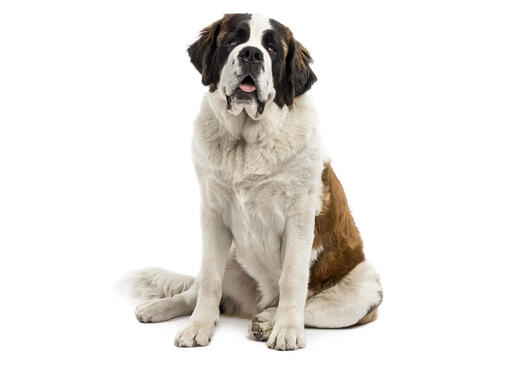
A massive, powerful dog, the Saint Bernard was originally bred to rescue freezing, stranded travelers during snowstorms in Switzerland. The breed has two coat varieties: Shorthair and Longhair. He has a gentle temperament, making the noble, intelligent Saint Bernard a superb companion and devoted family dog. This breed drools heavily, and his coat sheds frequently, requiring regular grooming.
DID YOU KNOW? The breed was named after Saint Bernard de Menthon, the patron saint of mountaineers and skiers.
ALSO KNOWN AS: St. Bernhardshund, Bernhardiner, Alpine Mastiff
The need-to-know
- Dog suitable for experienced owners
- Extra training required
- Enjoys active walks
- Enjoys walking an hour a day
- Giant dog
- Heavy drool
- Requires grooming daily
- Non hypoallergenic breed
- Chatty and vocal dog
- Guard dog. Barks, alerts and it's physically protective
- May require training to live with other pets
- May require training to live with kids
Personality

A 'gentle giant' sums up the character of the St. Bernard. They are good-humoured, trustworthy and love family life. They are very loyal dogs who rarely bark, but will defend you and your possessions if they deem necessary. They normally accept other household animals with no problems. Young dogs must be taught from an early age not to pull on their leads, as this habit will be problematic when they are older and enormous!
History and Origins

Country of Origin: Switzerland
The St. Bernard breed was developed in the 18th century by monks at a hospice offering aid and shelter to travellers in the Swiss Alps. It was recorded in 1774 that these dogs were being used as rescue dogs to locate travellers in need of help. Their fame grew and for a while they were called Good Samaritan Dogs. It’s thought that over 2000 travellers have been saved by St. Bernards.It isn’t just mountain rescue that St. Bernards excel at. One St. Bernard called Bamse, a ship’s dog of a Norwegian minesweeper in World War II, won a PDSA award for courage in action. He was stationed in Montrose, Scotland, and one of his duties was to collect his shipmates from the pubs at closing time! He became so well known in the town that upon his death in 1944, local schools closed to allow hundreds of children to attend his funeral. Today his grave is still honoured in Montrose.
Nutrition and Feeding

Giant-breed dogs, as well as having giant appetites, benefit from a different balance of minerals and vitamins, supporting different joint and cartilage needs. St. Bernard’s are prone to bloating and stomach problems; try feeding smaller, more frequent meals to help minimise the risk.
Exercise

Exercising St. Bernard puppies must be done very gradually to avoid putting excess strain on their growing bones and tender tissues and, even with the adult dog, care must taken to build up exercise gradually. Having said that, for their size they really do not need copious amounts of exercise – about an hour daily for an adult. They do however enjoy having their own large garden to be able to gently wander at leisure.
Other Information

Health and common issues
The most serious health problems commonly seen in the St. Bernard are various bone disorders, including bone cancer, epilepsy and heart disease. As with many breeds, they can also suffer from hereditary eye disorders and hip and elbow dysplasia (joint conditions that can lead to mobility problems). Eye testing and hip scoring of dogs prior to breeding is therefore important.
Space requirements
This is a dog who needs a large house and garden.
Training st. bernard’s
The St. Bernard is not one of the worlds obedience champions but they can be taught basic good manners. They should be taught to walk on a harness and lead from being quite young as when fully-grown they can be a real problem just by merit of their size and weight. Also teach a reliable recall as some people and other dogs might be intimidated by the approach of such a large dog.
Best family dog breeds
St. Bernard’s make excellent family dogs for older children but are just too big for younger ones. They are devoted to their families and make great companions - as long as no one minds being drooled on. While many dogs are traditionally thought of as being good with children, all dogs and children need to be taught to get on with and respect each other, and be safe together. Even so, dogs and young children should never be left alone together and adults should supervise all interactions between them.
Did you know?
- Monks attempted to cross the St. Bernard with the Newfoundland to create a thicker, warmer coat. However, this backfired as they found the longer fur captured matted snow and ice and weighed them down. You can still see the effects of this breeding in the longer haired variety of the St. Bernard.
- It can take up to three years for them to finish growing.
- In the film, Beethoven’s 2nd, over 100 puppies were used due to the fact that they grew so fast the production couldn’t keep up with them!
- Although history paints them with a barrel around their neck (supposedly filled with brandy), this is a myth and they never carried one at all.
- The most successful Saint Bernard rescue dog was called Barry and, in his lifetime, he rescued over 40 people from the Alps. His preserved body is now on display in the Natural History Museum of Bern.